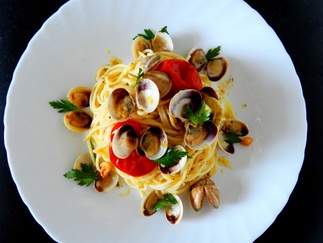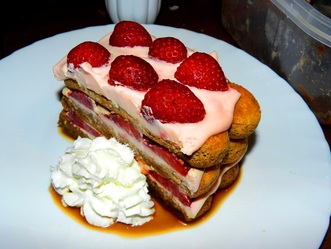
A simple dish inspired by Sardinia
Italian regional cuisines, no matter how different, are united by the common spirit of highlighting the best bounty of the region and of the season. Such is true up to the peripheries of the country - i.e. the non-peninsular island regions of Sicily and Sardinia, both of which are famous for good food inspired by other cultures they've come into contact with.
It's been almost a year now since I've been to Sardinia and I came back from there taking home this bag of curious couscous-like porous pasta - la fregola - one of the islands specialties. I remember being served this curious pasta paired with a nice seafood ragù - ever wondering whether it's pasta or a whole grain (with other Italians on the table wondering as well). This is the spirit of the dish I tried to recreate today. Being here in Naples inspired the concept of using just vongole verace which works perfectly well with spaghetti and I chose to use a semi-soffrito of garlic and bell pepper as base (a bit of a Spanish thing).
Ingredients:
400-450g of Fregola (serves 3)
500g of Vongole Verace or Medium-sized Clams
5-6 Cloves of Garlic
1 Bell Pepper, sliced or chopped
Green Beans, about 10-12 pieces, top and tail-trimmed and cut into two pieces
Cherry Tomatoes, about 8-10 pieces, halved
Olive Oil
White Wine
Parsley
Chili Flakes (optional though I recommend it, about 3 tsp. or 1 tbsp.)
1. The flavor base of this dish is a garlic oil made by heating extra-virgin olive oil (very low heat) and adding in some crushed and chopped cloves of garlic into the oil, allowing the garlic to slightly brown and infuse its flavor into the oil. When the garlic has sufficiently browned, add the chili flakes (optional, but I really recommend it as the spicy kick is nice with the seafood).
2. Add the sliced bell pepper and sauté until soft. While peppers are cooking, one can also add the cherry tomatoes, blistering them in the hot pan (crank up the heat a bit) as well as the green beans.
3. When the vegetables are about half-cooked (not totally done as they will continue to cook), add in some white wine and stir a bit to lift the caramelized bits on the pan. Add the fregola and add some more water (vegetable stock is an option for enhanced flavor but I find that the flavors can sufficiently develop without this).
4. The fregola must be cooked risotto-style in the pan - which means adding water (normally, hot stock) in parts and not all together in one go and letting the pasta absorb it and cook before adding some more. Let the pasta and vegetables cook thoroughly this way, tasting the texture of the pasta at each step.
5. When the pasta is significantly cooked - i.e. with some resistance but still shy of al dente, time to add the clams on the pasta and let them steam open, releasing their flavors into the dish. Continue adding water in the process as the further cooking may burn the pasta and hot water will steam to accelerate the opening of the clams. When all have opened (some stubborn ones might remain but those are probably the bad ones - I seldom get them here in Naples), the dish is ready.
6. Chop up some parsley coarsely (stalk and all) and mix into the dish before serving. Plate up the pasta at the bottom of the dish and the pasta-coated clams on top. Be generous and don't put cheese!.
It's been almost a year now since I've been to Sardinia and I came back from there taking home this bag of curious couscous-like porous pasta - la fregola - one of the islands specialties. I remember being served this curious pasta paired with a nice seafood ragù - ever wondering whether it's pasta or a whole grain (with other Italians on the table wondering as well). This is the spirit of the dish I tried to recreate today. Being here in Naples inspired the concept of using just vongole verace which works perfectly well with spaghetti and I chose to use a semi-soffrito of garlic and bell pepper as base (a bit of a Spanish thing).
Ingredients:
400-450g of Fregola (serves 3)
500g of Vongole Verace or Medium-sized Clams
5-6 Cloves of Garlic
1 Bell Pepper, sliced or chopped
Green Beans, about 10-12 pieces, top and tail-trimmed and cut into two pieces
Cherry Tomatoes, about 8-10 pieces, halved
Olive Oil
White Wine
Parsley
Chili Flakes (optional though I recommend it, about 3 tsp. or 1 tbsp.)
1. The flavor base of this dish is a garlic oil made by heating extra-virgin olive oil (very low heat) and adding in some crushed and chopped cloves of garlic into the oil, allowing the garlic to slightly brown and infuse its flavor into the oil. When the garlic has sufficiently browned, add the chili flakes (optional, but I really recommend it as the spicy kick is nice with the seafood).
2. Add the sliced bell pepper and sauté until soft. While peppers are cooking, one can also add the cherry tomatoes, blistering them in the hot pan (crank up the heat a bit) as well as the green beans.
3. When the vegetables are about half-cooked (not totally done as they will continue to cook), add in some white wine and stir a bit to lift the caramelized bits on the pan. Add the fregola and add some more water (vegetable stock is an option for enhanced flavor but I find that the flavors can sufficiently develop without this).
4. The fregola must be cooked risotto-style in the pan - which means adding water (normally, hot stock) in parts and not all together in one go and letting the pasta absorb it and cook before adding some more. Let the pasta and vegetables cook thoroughly this way, tasting the texture of the pasta at each step.
5. When the pasta is significantly cooked - i.e. with some resistance but still shy of al dente, time to add the clams on the pasta and let them steam open, releasing their flavors into the dish. Continue adding water in the process as the further cooking may burn the pasta and hot water will steam to accelerate the opening of the clams. When all have opened (some stubborn ones might remain but those are probably the bad ones - I seldom get them here in Naples), the dish is ready.
6. Chop up some parsley coarsely (stalk and all) and mix into the dish before serving. Plate up the pasta at the bottom of the dish and the pasta-coated clams on top. Be generous and don't put cheese!.
| Basing on their reaction, both my new chinese housemate and my visiting friend seemed to like it and the flavors are simple and good if nailed. I myself loved the dish and this is probably one I'll repeat again to showcase regional Italian cooking to other friends and visitors - next time, I'll try to make fregola by hand though (I've seen videos in youtube and it seems easier than making pasta!)... Buon appetito! | |



 RSS Feed
RSS Feed